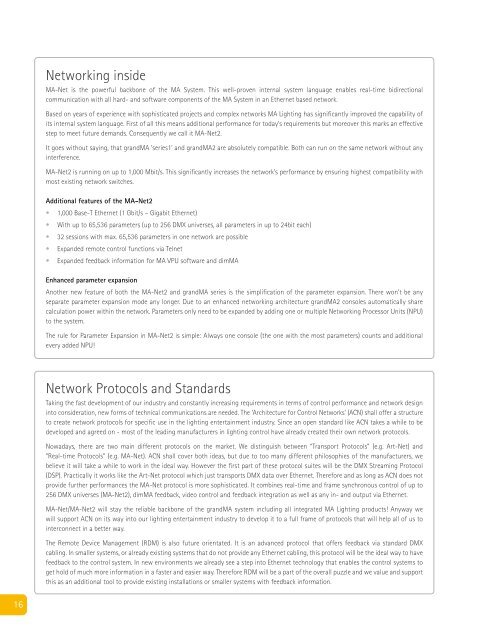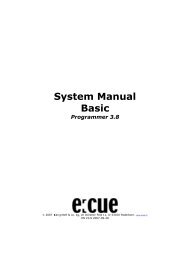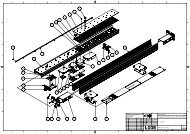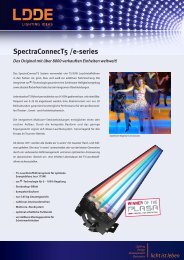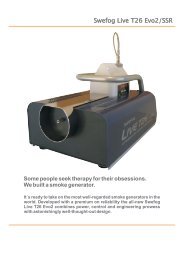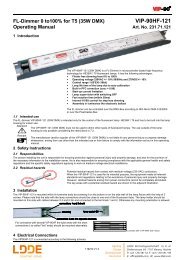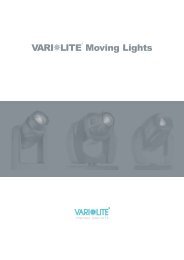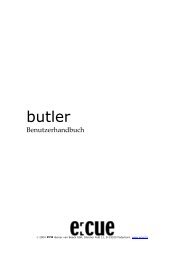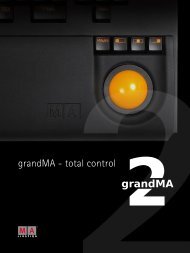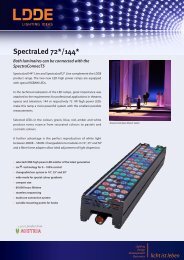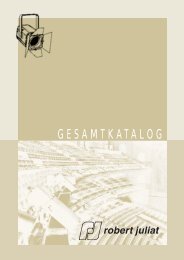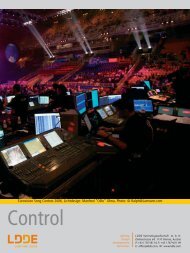grandMA - total control - LDDE Vertriebs GmbH
grandMA - total control - LDDE Vertriebs GmbH
grandMA - total control - LDDE Vertriebs GmbH
You also want an ePaper? Increase the reach of your titles
YUMPU automatically turns print PDFs into web optimized ePapers that Google loves.
16<br />
Networking inside<br />
MA-Net is the powerful backbone of the MA System. This well-proven internal system language enables real-time bidirectional<br />
communication with all hard- and software components of the MA System in an Ethernet based network.<br />
Based on years of experience with sophisticated projects and complex networks MA Lighting has significantly improved the capability of<br />
its internal system language. First of all this means additional performance for today’s requirements but moreover this marks an effective<br />
step to meet future demands. Consequently we call it MA-Net2.<br />
It goes without saying, that <strong>grandMA</strong> ‘series1’ and <strong>grandMA</strong>2 are absolutely compatible. Both can run on the same network without any<br />
interference.<br />
MA-Net2 is running on up to 1,000 Mbit/s. This significantly increases the network’s performance by ensuring highest compatibility with<br />
most existing network switches.<br />
Additional features of the MA-Net2<br />
• 1,000 Base-T Ethernet (1 Gbit/s – Gigabit Ethernet)<br />
• With up to 65,536 parameters (up to 256 DMX universes, all parameters in up to 24bit each)<br />
• 32 sessions with max. 65,536 parameters in one network are possible<br />
• Expanded remote <strong>control</strong> functions via Telnet<br />
• Expanded feedback information for MA VPU software and dimMA<br />
Enhanced parameter expansion<br />
Another new feature of both the MA-Net2 and <strong>grandMA</strong> series is the simplification of the parameter expansion. There won’t be any<br />
separate parameter expansion mode any longer. Due to an enhanced networking architecture <strong>grandMA</strong>2 consoles automatically share<br />
calculation power within the network. Parameters only need to be expanded by adding one or multiple Networking Processor Units (NPU)<br />
to the system.<br />
The rule for Parameter Expansion in MA-Net2 is simple: Always one console (the one with the most parameters) counts and additional<br />
every added NPU!<br />
Network Protocols and Standards<br />
Taking the fast development of our industry and constantly increasing requirements in terms of <strong>control</strong> performance and network design<br />
into consideration, new forms of technical communications are needed. The ‘Architecture for Control Networks’ (ACN) shall offer a structure<br />
to create network protocols for specific use in the lighting entertainment industry. Since an open standard like ACN takes a while to be<br />
developed and agreed on - most of the leading manufacturers in lighting <strong>control</strong> have already created their own network protocols.<br />
Nowadays, there are two main different protocols on the market. We distinguish between “Transport Protocols” (e.g. Art-Net) and<br />
“Real-time Protocols” (e.g. MA-Net). ACN shall cover both ideas, but due to too many different philosophies of the manufacturers, we<br />
believe it will take a while to work in the ideal way. However the first part of these protocol suites will be the DMX Streaming Protocol<br />
(DSP). Practically it works like the Art-Net protocol which just transports DMX data over Ethernet. Therefore and as long as ACN does not<br />
provide further performances the MA-Net protocol is more sophisticated. It combines real-time and frame synchronous <strong>control</strong> of up to<br />
256 DMX universes (MA-Net2), dimMA feedback, video <strong>control</strong> and feedback integration as well as any in- and output via Ethernet.<br />
MA-Net/MA-Net2 will stay the reliable backbone of the <strong>grandMA</strong> system including all integrated MA Lighting products! Anyway we<br />
will support ACN on its way into our lighting entertainment industry to develop it to a full frame of protocols that will help all of us to<br />
interconnect in a better way.<br />
The Remote Device Management (RDM) is also future orientated. It is an advanced protocol that offers feedback via standard DMX<br />
cabling. In smaller systems, or already existing systems that do not provide any Ethernet cabling, this protocol will be the ideal way to have<br />
feedback to the <strong>control</strong> system. In new environments we already see a step into Ethernet technology that enables the <strong>control</strong> systems to<br />
get hold of much more information in a faster and easier way. Therefore RDM will be a part of the overall puzzle and we value and support<br />
this as an additional tool to provide existing installations or smaller systems with feedback information.


